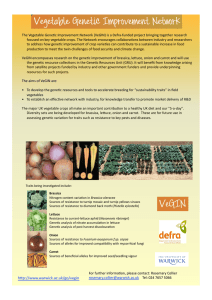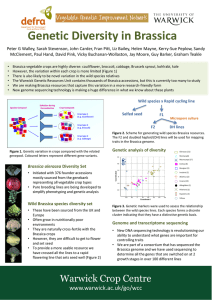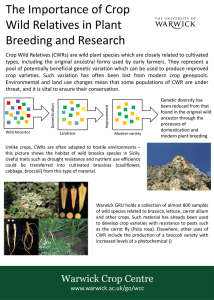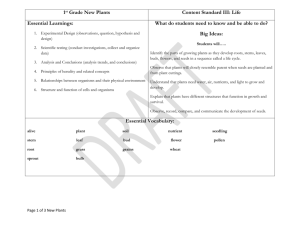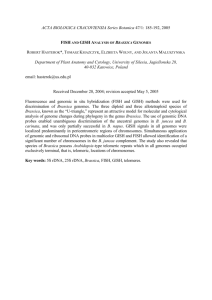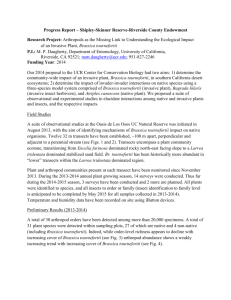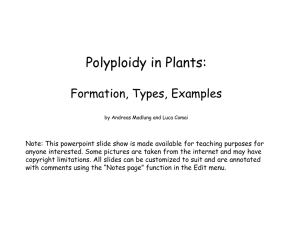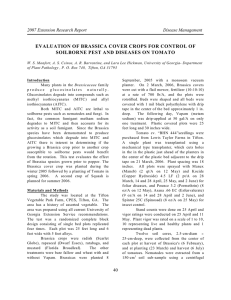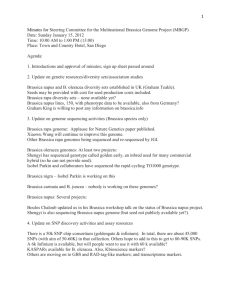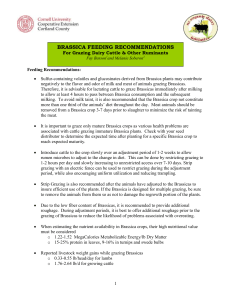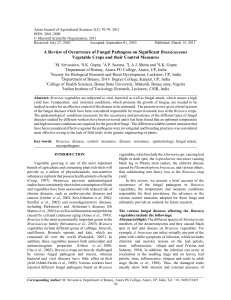Document 13202606
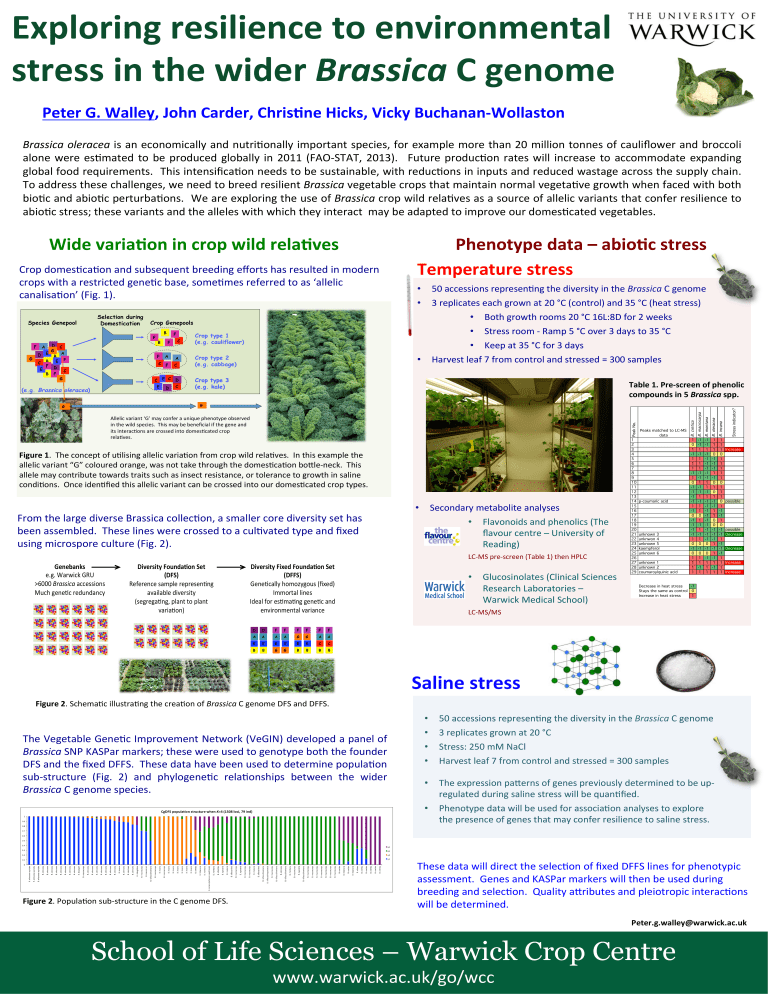
Exploring resilience to environmental stress in the wider Brassica C genome
Peter G. Walley, John Carder, Chris=ne Hicks, Vicky Buchanan-‐Wollaston
Brassica oleracea
is an economically and nutriMonally important species, for example more than 20 million tonnes of cauliflower and broccoli alone were esMmated to be produced globally in 2011 (FAO-‐STAT, 2013). Future producMon rates will increase to accommodate expanding global food requirements. This intensificaMon needs to be sustainable, with reducMons in inputs and reduced wastage across the supply chain.
To address these challenges, we need to breed resilient
Brassica
vegetable crops that maintain normal vegetaMve growth when faced with both bioMc and abioMc perturbaMons. We are exploring the use of
Brassica
crop wild relaMves as a source of allelic variants that confer resilience to abioMc stress; these variants and the alleles with which they interact may be adapted to improve our domesMcated vegetables.
Wide varia=on in crop wild rela=ves
Crop domesMcaMon and subsequent breeding efforts has resulted in modern crops with a restricted geneMc base, someMmes referred to as ‘allelic canalisaMon’ (Fig. 1).
Phenotype data – abio=c stress
Temperature stress
• 50 accessions represenMng the diversity in the
Brassica
C genome
• 3 replicates each grown at 20 °C (control) and 35 °C (heat stress)
• Both growth rooms 20 °C 16L:8D for 2 weeks
• Stress room -‐ Ramp 5 °C over 3 days to 35 °C
• Keep at 35 °C for 3 days
• Harvest leaf 7 from control and stressed = 300 samples
Table 1. Pre-‐screen of phenolic compounds in 5 Brassica spp.
G
G
Allelic variant ‘G’ may confer a unique phenotype observed in the wild species. This may be beneficial if the gene and its interacMons are crossed into domesMcated crop relaMves.
Figure 1
. The concept of uMlising allelic variaMon from crop wild relaMves. In this example the allelic variant “G” coloured orange, was not take through the domesMcaMon bogle-‐neck. This allele may contribute towards traits such as insect resistance, or tolerance to growth in saline condiMons. Once idenMfied this allelic variant can be crossed into our domesMcated crop types.
From the large diverse Brassica collecMon, a smaller core diversity set has been assembled. These lines were crossed to a culMvated type and fixed using microspore culture (Fig. 2).
!"#"$%#&'(
!"#"$%&'()*+$,-.$
/0111$ !"#$$%&# $&**!22)342$
56*7$#!4!8*$'!9649&4*:$
)*+",'*-.(/01#2%30#(4"-((
5)/46(
-!;!'!4*!$2&<=>!$'!='!2!484#$
&?&)>&@>!$9)?!'2)A:$
B2!#'!#&84#C$=>&4A$A3$=>&4A$
?&')&834D$
)*+",'*-.(/*7"2(/01#2%30#(4"-(
5)//46(
,!4!8*&>>:$73<3E:#362$BFG!9D$
H<<3'A&>$>)4!2$
H9!&>$;3'$!28<&84#$#!4!8*$&49$
!4?)'34<!4A&>$?&')&4*!$
$
D D
A A
E E
B B
F F
A A
E E
G G
F F
G G
E E
B B
F F
A A
C C
B B
• Secondary metabolite analyses
!
•
Flavonoids and phenolics (The flavour centre – University of
Reading)
LC-‐MS pre-‐screen (Table 1) then HPLC
•
Glucosinolates (Clinical Sciences
Research Laboratories –
Warwick Medical School)
LC-‐MS/MS
Peaks matched to LC-MS data
7
8
5
6
3
4
1
2
9
10
11
12
13
14 p-coumaric acid
15
16
17
18
19
20
21 unknown 3
22 unknwon 4
23 unknown 5
24 kaempferol
25 unknown 6
26
27 unknown 1
28 unknown 2
29 coumaroylquinic acid
1 -1 -1 1 1
0 -1 -1 1 1
1 1 1 1 1 Increase
-1 -1 -1 0 0
1 1 -1 -1 1
1 1 -1 -1 1
1 1 -1 -1 1
-1 -1 -1 1 1
1 -1 -1 -1 1
0 1 1 0 0
-1 -1 1 1 1
-1 -1 -1 0 1
-1 1 1 1 1
-1 -1 -1 -1 0 possible
1 1 -1 -1 1
-1 1 -1 1 -1
0 0 -1 1 -1
-1 1 -1 0 1
-1 -1 -1 0 0
-1 1 -1 -1 -1 possible
-1 -1 -1 -1 -1 Decrease
1 1 -1 -1 1
0 0 0 1 -1
-1 -1 -1 -1 -1 Decrease
0 0 0 1 -1
1 1 -1 -1 1
1 1 1 1 1 Increase
1 -1 1 -1 1
1 1 1 1 1 Increase
Decrease in heat stress -1
Stays the same as control 0
Increase in heat stress 1
Saline stress
Figure 2
. SchemaMc illustraMng the creaMon of
Brassica
C genome DFS and DFFS.
The Vegetable GeneMc Improvement Network (VeGIN) developed a panel of
Brassica
SNP KASPar markers; these were used to genotype both the founder
DFS and the fixed DFFS. These data have been used to determine populaMon sub-‐structure (Fig. 2) and phylogeneMc relaMonships between the wider
Brassica
C genome species.
• 50 accessions represenMng the diversity in the
Brassica
C genome
• 3 replicates grown at 20 °C
• Stress: 250 mM NaCl
• Harvest leaf 7 from control and stressed = 300 samples
• The expression pagerns of genes previously determined to be up-‐ regulated during saline stress will be quanMfied.
• Phenotype data will be used for associaMon analyses to explore the presence of genes that may confer resilience to saline stress.
Figure 2
. PopulaMon sub-‐structure in the C genome DFS.
These data will direct the selecMon of fixed DFFS lines for phenotypic assessment. Genes and KASPar markers will then be used during breeding and selecMon. Quality agributes and pleiotropic interacMons will be determined.
Peter.g.walley@warwick.ac.uk
